Early iPhone 7 Teardowns: Intel & Qualcomm Modems, TSMC SoC, 2 to 3 GB of RAM
by Ryan Smith on September 16, 2016 10:15 AM EST- Posted in
- Smartphones
- Mobile
- iPhone 7
- iPhone 7 Plus
- Chipworks
- iFixit
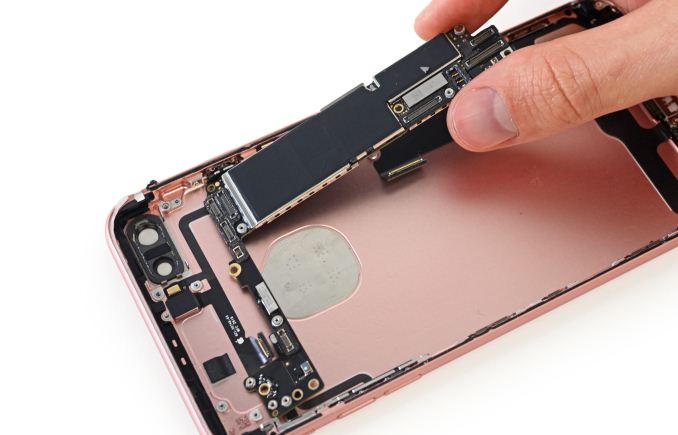
Today is launch date for Apple’s new iPhone 7 models, and as is tradition every year, the teardowns have already begun. Both the Chipworks/TechInsights team and iFixit have completed their respective initial teardowns of the iPhone 7 and 7 Plus, tearing part some of the first phones to go on sale. These teardowns are preliminary – there’s a lot of work left to do in deciphering the many cryptic identification numbers of the various components – but right off the bat it confirms a few things about each of the phones.
We’ll start off with the Chipworks teardown of an iPhone 7, which they have already earnestly begun identifying chips on. One of their immediate findings is that for the first time in a while, Apple is using a non-Qualcomm modem. On Chipworks’ GSM phone, they have found an Intel baseband processor with the model number PMB9943. They believe this to be part of Intel’s XMM 7360 modem, which was announced back in 2015.
The XMM 7360 is a high-end LTE Advanced modem design that offers up to Category 10 performance (450 Mbps down). This is achieved in part through the use of 3x carrier aggregation, which allows the modem to use up to 60Mhz of wireless spectrum. The modem does not support CDMA, and as the iFixit team has turned up a Qualcomm Snapdragon X12 (Cat 12) modem in their unit, Apple is clearly using modems from multiple vendors. It’s not clear how this breakdown works – if Apple is using the Qualcomm modem in some GSM phones as well – but at a minimum the Qualcomm modem will have to be in all of the CDMA-capable models.
Meanwhile for Intel’s modem group, this is a significant win, as the company has not seen too many high-profile device wins in recent years. Though historically speaking, this is actually something of a return to form. The original iPhone used a modem from the group’s predecessor, Infineon’s wireless unit, whom Intel purchased in 2010.
Moving on, we have of course the A10 Fusion SoC. Chipworks has yet to get a die shot in, but they have already confirmed that the SoC is produced by TSMC. This is presumably another 16nm FinFET SoC, but the Chipworks team will be working to confirm that. So far there is no evidence to indicate that Apple is dual-sourcing SoCs on the iPhone 7 like they did the iPhone 6s, but this is again preliminary information.
Given that Apple doesn’t get a major new manufacturing process to use this generation, I had been wondering if and how Apple would instead compromise on die size, and we now have a rough answer. Chipworks estimates the A10 die to be roughly 125mm2 in size. This is 20.5mm2 (~20%) larger than the A9 TSMC die. The good news for Apple is that yields should be much better in 2016 than they were in 2015, so chip manufacturing costs should be down, helping to offset the higher costs of the larger chip. And while there are ways to improve performance without increasing the die size, any kind of significant improvement would have to entail a larger die, which is exactly what we’re seeing here. If nothing else, Apple would need more room for the new high-efficiency CPU cores the chip packs in.
Speaking of packing, Chipworks’ teardown also hints that the A10 may have been packaged using TSMC’s new Integrated Fan Out (InFO) technique, which is meant to allow for thinner chip packages. InFO saves space, in part, by eliminating the organic substrate that logic dies have traditionally been mounted on.
Lastly with the A10, Chipworks’ teardown of their iPhone 7 confirms that it has 2GB of RAM, specifically Samsung LPDDR4. Besides confirming that the memory capacity on the iPhone 7 hasn’t increased versus the iPhone 6s, this is notable because iFixit has found something different with their iPhone 7 Plus. In the case of the larger phone, there is 3GB of RAM. Apple has never before equipped the Plus with more memory than the base model, so this is a first. And while there has always been some performance stratification between the two phones due to the Plus model’s larger size – allowing better heat dissipation, and therefore slightly better performance – I wonder if this means we’re going to see an increase in the stratification between the two phone models. If nothing else, I suspect this comes as a consequence of the Plus’s higher resolution screen: all other factors being held equal, the Plus needs a bit more RAM for its larger GPU frame buffers.
Update: The Chipworks crew has their die shot and floor plan back, so let's take a look.
As Apple already disclosed the number of GPU clusters, there's not a whole lot left to doubt in terms of basic construction.The GPU cores, SRAM caches, and the performance CPU cores are all easy enough to find, with the latter block now about 16mm2, versus 13mm2 in the A9. The big question here is where the two smaller, high-efficiency cores are. Chipworks postulates three thories: 1) They're in the same block as the high performance cores (and hence labeled as a quad core CPU), they're to the left of the die, or they're to the bottom left of the die.
It is likely - but not guaranteed - that they're close to the high-performance cores. However both alternative locations do have pairs of identical blocks, which is what you'd be looking for in a secondary set of CPU cores. So although those options are less likely, without additional information it's difficult to rule out those options entirely.
Finally, one interesting aspect of the Chipworks report is that they unexpectedly found a third audio amplifier. Chipworks was expecting to find two – one for each of the speakers – but came up with a third. The firm believes that the third amp may be for headphones, which in turn would mean that Apple has significantly revised the Lightning port specification for the iPhone 7. Previously Lightning has only carried digital audio, which doesn’t require an amp in the phone itself. In the initial iPhone 7 announcement I had speculated that Apple put the DAC (and amp) inside their 3.5mm adapter – which would be consistent with how Lightning has worked over the last 4 years – but this casts doubt on that idea. If Apple has revised the specification to allow analog audio over the port, then this greatly simplifies how headphones and adapters will work. But it also would raise a number of questions about peripheral compatibility, especially what happens if you plug something like the Lightning EarPods into an older device like the iPhone 5s.
On that note, the Chipworks and iFixit teardowns also show us what’s gone in the place of the now-absent headphone jack: Apple has placed a taptic engine (linear actuator) for the solid state home button, and an unusual plastic bumper.
Wrapping things up, Chipworks’ reports that they already have the A10 SoC in their lab for further work, including confirming the manufacturing process and, of course, a die shot. The latter should prove to be very interesting, as it will be the first look we get at Apple’s new high-efficiency CPU cores. And in the meantime on our end we also have our iPhone samples in-house, so we’re diligently working on putting together a review for later this month. So be sure to stay tuned for that.


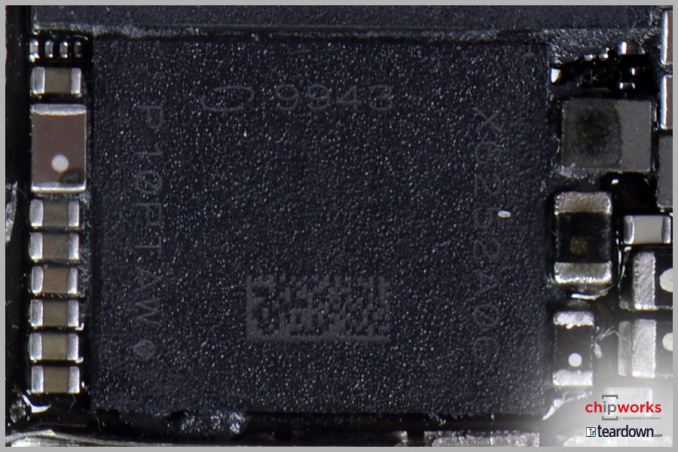
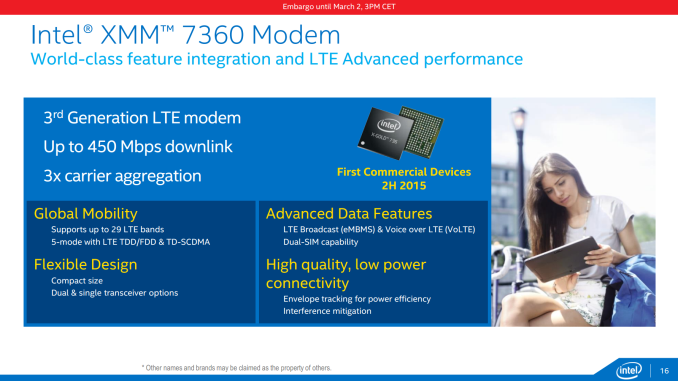
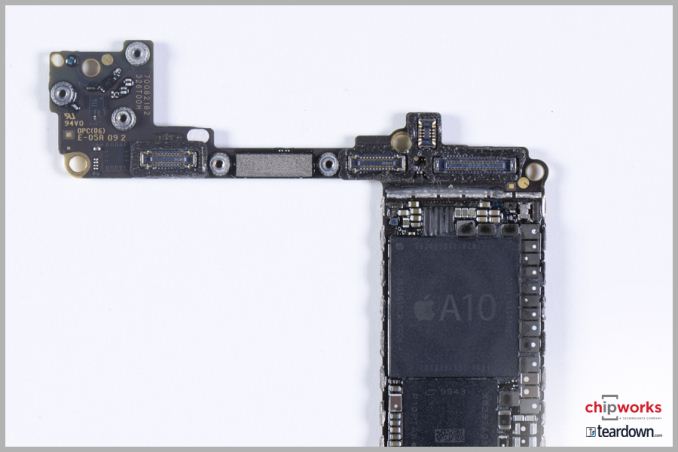

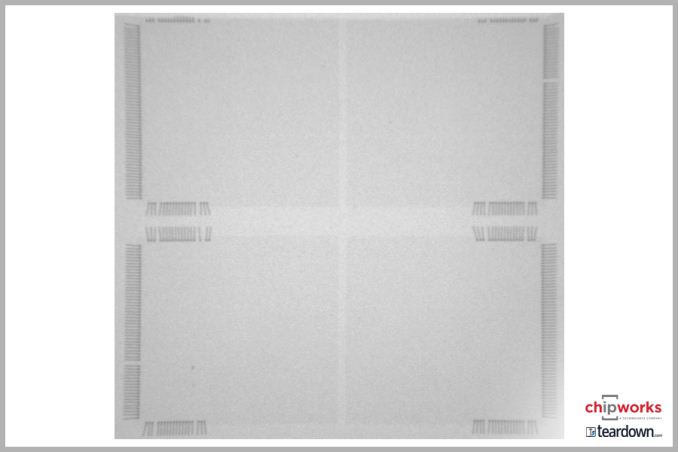
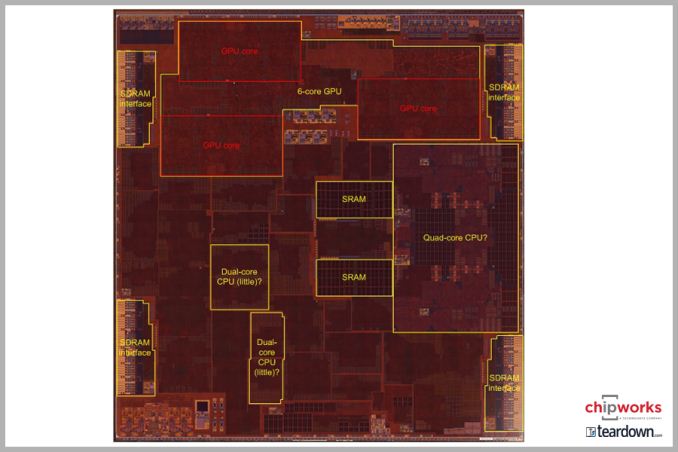
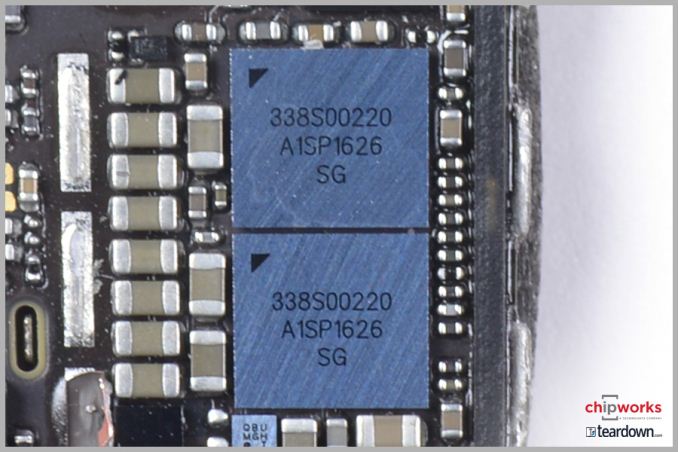
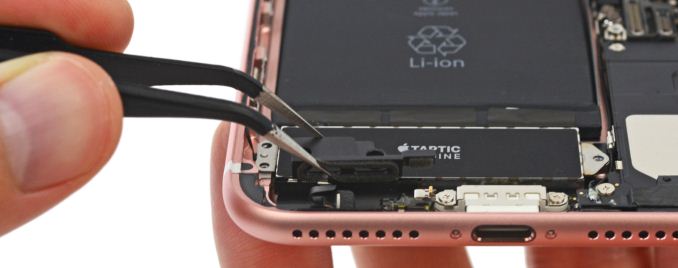








96 Comments
View All Comments
evefavretto - Friday, September 16, 2016 - link
Worth noting that the iFixit 7 Plus is a Japanese model(A1785). That probably explain the Qualcomm modem, since it has CDMA.Spoony - Friday, September 16, 2016 - link
I'm waiting patiently on the camera sensor sizes and lens Z-Depth. The only site I can find which digs in a little on this is here: http://www.astramael.com/5And they are, as they say, just speculating. The computed EXIF claims don't appear to be valid?
Ej24 - Friday, September 16, 2016 - link
Interesting that theres a DAC upstream of the lightening port. It makes sense to put it there rather than the adapter/dongle because that would make the dongle 10x more expensive. Though this does somewhat negate the reason for foregoing the 3.5mm jack as the DAC is still taking up space.Personally I'm glad they kept the DAC in the phone, I've used micro-usb to 3.5mm on my Galaxy S6 with standard headphones, out of curiosity, and it was an abhorred experience without a DAC anywhere in-line. The worst sound quality i've ever experienced. Unfortunately I can imagine many android OEM's not including a DAC in their phones without 3.5mm, leading to horrible experience when using headphones without an internal DAC. Now we'll all have to pay attention to who has the best DAC in their headphones. We're really no better off...
solipsism - Friday, September 16, 2016 - link
" Though this does somewhat negate the reason for foregoing the 3.5mm jack as the DAC is still taking up space."Not as much as the audio jack component. Plus, the DAC is a flat chip that can be placed pretty much anywhere, and the port component uses the internal thickness and has to placed on an edge, and on the top or bottom.
name99 - Friday, September 16, 2016 - link
And, once again, there is a longer game here --- maybe the reason Apple succeeds is that they are thinking three years ahead, not three weeks ahead?The longer term game is, of course, universal wireless headphones, and AirBuds as Apple's second wearable platform. (Why not immediate wireless? My guess is that, at least in part, Apple want to see how different wireless form factors play out --- do people prefer larger headsets? Do they want a cord joining the two buds? Are they comfortable with the stalks that hold the AirBud mics? etc. They will, I am sure, be very closely tracking the sales of AirBuds compared to the different wireless form factors that Beats offers.)
There are many ways this could play out. For example Apple could also sell the W1 chip to third parties as its first "Apple Inside" piece of hardware. Most of the value for Apple of the W1 is in the way it works well with the rest of the Apple ecosystem; so there's really no downside to Apple becoming a chip vendor for Bose, Sennheiser, etc. And once Apple get's comfortable selling its first chip, the way opens for them to grow a whole new business on the side...
lilo777 - Friday, September 16, 2016 - link
What's W1? I am pretty sure it's just a simple SOC with standard BT and a few extra Apple-specific features. Why would anyone even want to license it?name99 - Friday, September 16, 2016 - link
Uhh, to GET those "few extra Apple-specific features." Duh.stux - Friday, September 16, 2016 - link
Yes, if upgrade both my phone and Bose headphones if Bose came out with a W1 enabled set of qc headphonesDeath666Angel - Friday, September 16, 2016 - link
How can you get any sound without a DAC? Or was the DAC in the microUSB to 3.5mm adapter?I think this will just further muddy the waters, now there will be DAC enabled lighting headphones, non-DAC lightning headphones, people using them on older iPhones. I wouldn't want to be someone having to explain any of that to your typical iPhone user.
Constructor - Saturday, September 17, 2016 - link
You're describing the problems correctly which would indeed be a consequence of such a design, but the new adapter actually works with all Lightning devices according to Apple themselves, including the oldest ones which definitely needed an external DAC for Lightning audio; So the only possible conclusion is that the new adapter does in fact contain its own DAC, as all other Lightning audio devices have before it.